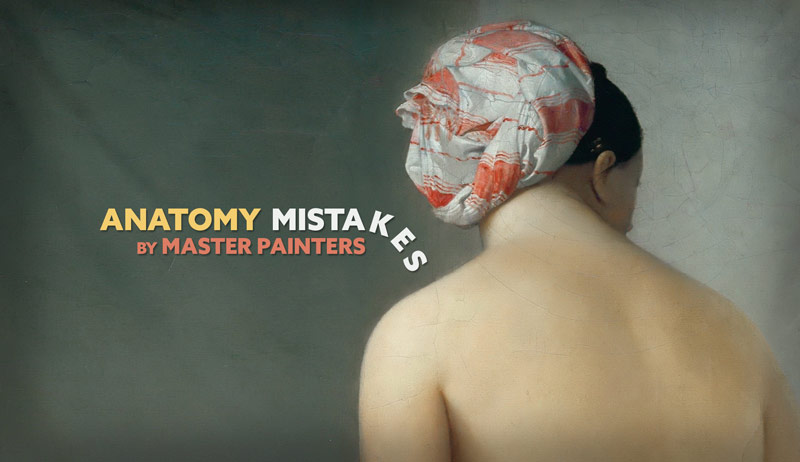Anatomy Mistakes by Master Painters – Does it Matter?

#647
Thanks for joining in everyone, the support is much appreciated!
Today we are going to look at a ton of amazing master paintings full of what some might call “anatomy mistakes.” Did masters make mistakes? Does it even matter? Let’s dig a little deeper and see what we can find!
The Backstory Anatomy Mistakes
This whole article was inspired by a comment I heard in the Louvre, Paris. I was drawing a master copy of a Jean-Auguste-Dominique Ingres painting…see, here I am in this glorious SOOC pic. Oh, and allow me to point out some major composition errors in this photo while we’re at it.
It’s obvious that the person used the rule of thirds to compose the photo. Nailed it…right on a third…perfect. But this is a great example of how it can mislead beginners. As it was nice of the person to take a photo of me, it would’ve been really great to have one without edge flicker (guy on the left) (see Day 49), bad figure-ground relationship (people behind my head) (see Day 21), and a tilted horizon line when spontaneity was non-existent (see #412). This one would take a lot of Photoshop to make it look nice, and I’m not referring to my face.

Anyway, enough pretentious ranting, back to the story. As I was sitting there drawing I heard an elderly man say something like “a museum full of paintings…riddled with anatomy mistakes.” He was looking right at me when he said it, but I just smiled and continued to draw. Was he right? Were these mistakes, or did the master artist paint the figure exactly as they wanted it to be?
Let’s look at some more paintings further below and see what we can come up with.


Mistakes, Exaggerations & Distortions Anatomy
When it comes to analyzing master painters, we may as well start with one of the best. William-Adolphe Bouguereau was a master that had exceptional technique and design sensibilities (see Day 65). But does that mean he didn’t make a mistake here and there? Is anyone perfect?
When you look at the painting below, are you able to see anything wrong with the anatomy, or does it look normal?
Look closely at the vampire guy with orange hair. His neck seems a bit long, don’t you think? It could be the values around the shoulder/neck/back area that creates this illusion, but it’s clearly not anatomically correct. Does this ruin the painting? Was Bouguereau not a master after all? Well, you should know the answer is absolutely not. The painting is dramatic, well designed, and executed with mastery. So Bouguereau didn’t get the anatomy absolutely perfect, big deal. This is exactly why I remained quiet after the elderly man commented on the museum paintings being full of “bad anatomy.” It doesn’t matter.

Here’s another Bouguereau painting that has less than perfect anatomy. It could also be a foreshortening issue. Look at the guy flying on top; his right hand is closer to us, so it should be a little bigger than his left hand. They look equal in size…same with the feet. There’s also a design flaw where the higher foot coincides, or “kisses,” the wing (see Day 48). Do these things ruin the painting? No, and they would probably go unnoticed by most viewers.

Speaking of master painters, Michelangelo was undeniably one of the best. Just check out these drawings below…the anatomy is pretty spot on. He was mostly known for his work on the Sistine Chapel Ceiling, so let’s see how he did there…

Hmmm, what do you think. These paintings look a little…distorted…squished from top to bottom. Perhaps it’s the way he designed it, the angle that the photo was taken, not sure. But if we are viewing these images as they are in real life, they are not 100% anatomically correct. Does it ruin the Sistine Chapel ceiling? Well, as Aristotle said, “the whole is greater than the sum of its parts.” There are tons of paintings on the ceiling to make up one masterpiece. It won’t make a difference if every figure is’nt anatomically correct.

Here’s another example from the ceiling, where the man in the middle and the guy on the right look shorter and wider than what the eye is use to seeing. No biggie.

Ingres had anatomy issues in almost all of his paintings. Doesn’t mean he wasn’t a talented master painter. Some artists worry about getting the anatomy perfect in their art, but we’ve got plenty of proof that it doesn’t matter. Just look at this next painting by Ingres…a painting that is gracefully hanging in the Musee d’Orsay, Paris. These type of anatomical imperfections tend to make the piece look more original. When you paint from imagination it can increase these imperfections, while simultaneously increasing the perceived originality. We’ll see some examples of that further below, but for now let’s look at some more Ingres paintings.
Look at the woman’s right arm by her waistline. It’s much too long. If she straightened it out she could probably scratch her knee.
The hip is a little wider in this Ingres…still a great piece of art though.
Lots of figures in this Ingres, but the one on the right is probably the one that lacks the most anatomical accuracy. Such a great painting though!
This one is by Franz-Xaver-Winterhalter, where the woman’s right arm seems a little smaller than it should be. Another beautiful painting that loses nothing from this anatomical flaw.
Edgar Degas has plenty of excellent, well designed paintings, but he was no stranger to anatomy errors. This woman’s left arm seems like it was broken near the shoulder. She’s also got a really bulky trapezius muscle and neck for a woman.
Gustave Courbet painted this one. See any anatomy errors here? I’m sure it inspired Sir Mix-a-Lot when he was creating his famous rap song. It’s still a really remarkable piece of art though.
Here we have Jean-Baptiste-Camille Corot doing a nice job on the body, but making the face a little wide for the head.
Some artists like Pablo Picasso purposely distort (left) and exaggerate (right) figures, which is part of their artistic style (see Day 122).
Here’s Peter Paul Rubens taking the human arm and exaggerating the muscles. Looks pretty cool, right!? As we’ve seen, anatomy definitely doesn’t have to be perfect. And when you’re creating from imagination you’ll be able to get something that is more unique than a direct photorealistic drawing.
More distortions from good ol’ Pablo. Original? You better believe it!
These next two are by Francisco Zuniga. One is exaggerated (left) and the other distorted (right).
Here are a couple more by Zuniga. What do you think? Would you prefer them to be 100% anatomically correct, or do they work well for you as they are?
Guess who did this one? Vincent Van Gogh! Definitely not anatomically correct, but we can see his artistic style coming through.
These next two are by Van Gogh. Pretty scary if you ask me, but still works of art.
In this Van Gogh painting, we can see that the woman’s left arm is a little longer.
Suzanne Valadon created these great paintings. The anatomy is “bulgy” but the paintings possess a more original look.
Sandro Botticelli exaggerated his Venus in this next painting. Just look at her left arm…she could touch the moon with that thing! Doesn’t diminish the quality of the painting though.
If you’re picky with anatomy, try to skip past these two pieces by Rembrandt.
Yikes Rembrandt, what were you thinking!? Hey, it’s still masterfully done despite the distorted figure.
Pierre-Auguste Renoir was no stranger to painting exaggerated figures. Look how huge the body is compared to the face. Still has that original look though, doesn’t it?
Aside from her body, the face also seems a bit distorted.
As we saw before, Rubens loved to exaggerate the figure by adding lots of extra lumps and bumps. The woman in the center-left has legs that look disproportioned, while the woman to her right has a knee that looks too bulky.
Here’s three more paintings by Rubens. Can you find any of his anatomy exaggerations/distortions/flaws?
This one is by Piero della Francesca. How did he do? Anatomically correct, or leaning on the original side?
I’m a big fan of Picasso’s distorted figures and they’ve influenced some of my art (see #576 & #589). Go through these next few pieces and see how he uses these distortions to create more original work. Not to say you can’t have originality without distortions, but in Picasso’s case, it definitely helped solidify his unique style.
Scroll through these next paintings and see if you can identify the anatomical accuracy. Is there any? Does it ruin the painting? Does it make the painting more original? What style do you prefer best? Answering these questions will help you when creating your own art and developing your own style. Even if you don’t paint, this exercise might allow you to enjoy a museum even more the next time you visit.















Conclusion
Whew, you finished another juicy article full of amazing paintings! As we saw, there are many great masterpieces with “anatomy flaws” but it doesn’t ruin the work. Well, maybe those scary Van Gogh pieces, but other than that any flaws would go unnoticed by many viewers. In addition, some exaggerations and distortions are invited to bring a more original look to the art. If you’re obsessed with getting anatomy correct in your art, or make fun of it in a museum like that elderly man, try to see things differently.
That’s it for this one. As always, thanks for the support. See you in the next one!



































